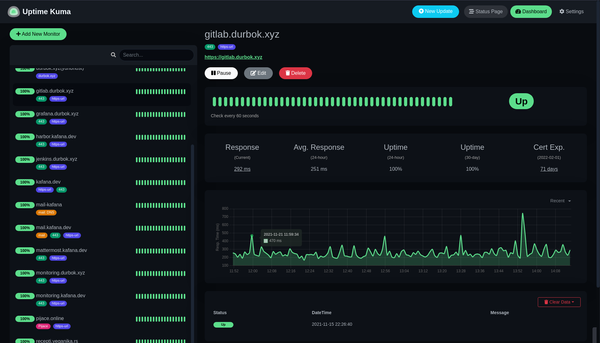How To Install Ghost For A Production | Docker Swarm
You'll need Linux server, Public IP, domain name, ssl and docker installed running in swarm.
Check docker installation here if you're using ubuntu 20.04:

We'll be using docker (swarm) for mysql-8, nginx and ghost.
I like to have separate stacks when working with docker swarm.
Mysql Step:
Create a folder for your mysql and cd into it. Then create two more folders.
mkdir conf.d dbdataCreate a file inside conf.d called custom.cnf.
nano conf.d/custom.cnfAdd:
[mysqld]
sql-mode="STRICT_TRANS_TABLES,NO_ENGINE_SUBSTITUTION"
default-authentication-plugin=mysql_native_password
character-set-server=utf8
collation-server=utf8_general_ciCreate docker-compose.yml and edit.
version: "3.7"
services:
prod:
image: mysql8
hostname: mysql-8
command: '--default-authentication-plugin=mysql_native_password'
networks:
- durbok-net
deploy:
placement:
constraints:
- node.role == manager
replicas: 1
restart_policy:
condition: on-failure
volumes:
- ./conf.d:/etc/mysql/conf.d
- ./dbdata:/var/lib/mysql
environment:
MYSQL_ROOT_PASSWORD: supersecretpasshere
networks:
durbok-net:
external: trueCreate external docker network (you can use different name) but append it also in docker-compose.yml file.
docker network create -d overlay durbok-netDeploy Mysql8.
docker stack deploy -c docker-compose.yml mysql8Create database and database user for ghost.
Enter mysql container with docker exec -it and bash in the end.
docker exec -it mysql8_prod.xxxxxxxxxxxxxx bash

Next run and type in your previously defined password for mysql (in docker-compose.yml).
mysql -u root -pYou should get:
mysql>
Creating database and user check:

Don't forget to give user rights over db and flush privileges. Also this db container can be used for other projects like other ghost or wordpress sites.
Lets setup ghost.
Create a folder for ghost and cd into it. Create a docker-compose.yml.
version: "3.7"
services:
prod:
image: ghost:alpine
volumes:
- ./content/images:/var/lib/ghost/content/images
- ./content/themes:/var/lib/ghost/content/themes
- ./content/apps:/var/lib/ghost/content/apps
- ./content/data:/var/lib/ghost/content/data
environment:
- url=https://blog.kafana.dev # add your domain here
- database__client=mysql
- database__connection__host=mysql8_prod # db host (name of the docker service)
- database__connection__user=db_user
- database__connection__password=db_pass
- database__connection__database=db_name
- database__pool__min=0
- VIRTUAL_PORT=2368
networks:
- durbok-net
deploy:
placement:
constraints:
- node.role == manager
replicas: 1
restart_policy:
condition: on-failure
networks:
durbok-net:
external: trueCreate following folders for data persistence.
mkdir -p content/{images,themes,apps,data}Deploy:
docker stack deploy -c docker-compose.yml ur_nameLets setup nginx:
Same as before. Create a separate folder and cd into it.
mkdir nginx-confCreate docker-compose.yml.
version: '3.7'
services:
prod:
image: nginx:stable-alpine
volumes:
- ./nginx-conf:/etc/nginx/conf.d
- /path/to/ssl:/etc/nginx/ssl
- /path/to/static/webfolder:/var/www/html/webfolder # optional
networks:
- durbok-net
deploy:
placement:
constraints:
- node.role == manager
replicas: 1
restart_policy:
condition: on-failure
ports:
- 80:80
- 443:443
networks:
durbok-net:
external: true
volumes:
nginx-conf:For creating ssl I'll create separate post and link it here.
Before we deploy nginx create ur_name.conf file inside nginx-conf folder.
Something like this:
server {
listen 80;
listen [::]:80;
server_name blog.kafana.dev; # add you domain here
rewrite ^ https://$http_host$request_uri? permanent;
}
server {
listen 443 ssl http2;
listen [::]:443 ssl http2;
server_name blog.kafana.dev; # add you domain here
error_log /var/log/nginx/blog.kafana.dev_error.log;
access_log /var/log/nginx/blog.kafana.dev_access.log;
location ^~ {
proxy_set_header Host $host:$server_port;
proxy_set_header X-Real-IP $remote_addr;
proxy_set_header X-Forwarded-For $proxy_add_x_forwarded_for;
proxy_set_header X-Forwarded-Proto $scheme;
client_max_body_size 256M;
# Fix the "It appears that your reverse proxy set up is broken" error.
proxy_pass http://blog_prod:2368;
proxy_read_timeout 90;
# Required for new HTTP-based CLI
proxy_http_version 1.1;
proxy_request_buffering off;
}
location ~ /\.(?!well-known).* {
deny all;
access_log off;
log_not_found off;
}
add_header Content-Security-Policy upgrade-insecure-requests;
ssl_certificate /etc/nginx/ssl/ur_ssl_here.pem;
ssl_certificate_key /etc/nginx/ssl/_ur_ssl_here.key;
# ssl_dhparam /etc/nginx/ssl/dhparams.pem;
ssl_session_timeout 5m;
ssl_session_cache shared:SSL:5m;
#SSL Security
ssl_protocols TLSv1 TLSv1.1 TLSv1.2;
ssl_ciphers 'EECDH+AESGCM:EDH+AESGCM:AES256+EECDH:AES256+EDH';
#XP and IE6 support
#ssl_ciphers 'ECDHE-ECDSA-AES256-GCM-SHA384:ECDHE-RSA-AES256-GCM-SHA384:ECDHE-ECDSA-CHACHA20-POLY1305:ECDHE-RSA-CHACHA20-POLY1305:ECDHE-ECDSA-AES128-GCM-SHA256:ECDHE-RSA-AES128-GCM-SHA256:ECDHE-ECDSA-AES256-SHA384:ECDHE-RSA-AES256-SHA384:ECDHE-ECDSA-AES128-SHA256:ECDHE-RSA-AES128-SHA256';
ssl_ecdh_curve secp384r1;
ssl_prefer_server_ciphers on;
ssl_session_tickets off;
proxy_set_header X-Forwarded-For $remote_addr;
#Compress and optimize delivery of files
gzip on;
gzip_comp_level 5;
gzip_min_length 256;
gzip_vary on;
gzip_types
application/atom+xml
application/javascript
application/json
application/ld+json
application/manifest+json
application/rss+xml
application/vnd.geo+json
application/vnd.ms-fontobject
application/x-font-ttf
application/x-web-app-manifest+json
application/xhtml+xml
application/xml
font/opentype
image/bmp
image/svg+xml
image/x-icon
text/cache-manifest
text/css
text/plain
text/vcard
text/vnd.rim.location.xloc
text/vtt
text/x-component
text/x-cross-domain-policy;
# text/html is always compressed by gzip module
}Just one more command.
docker stack deploy -c docker-compose.yml ur_name_hereAll done.
You can also use this nginx for other project just reload when adding new *.conf files with command:
docker exec -it nginx_xxxxxxxxxxxxxxxxxxxxxx nginx -s reload



